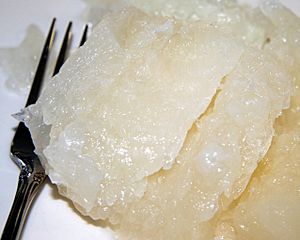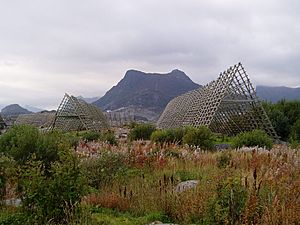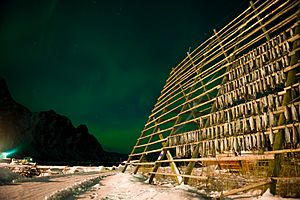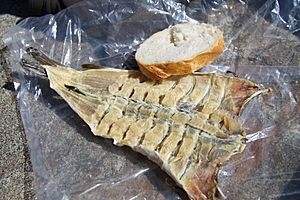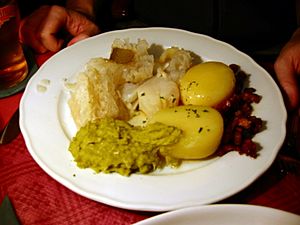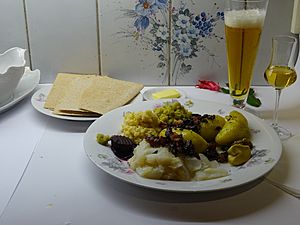Lutefisk facts for kids
Lutefisk is a special type of dried fish, usually made from cod. It's a traditional food in several Nordic countries like Norway, Sweden, and Finland. The name "lutefisk" means "lye fish" because it's soaked in a special solution called lye to prepare it. After soaking for many days, it becomes soft and jelly-like. People often eat lutefisk during Christmas celebrations.
Contents
What is Lutefisk and How is it Made?
Lutefisk starts as dried whitefish, often cod. This dried fish is called stockfish. To make lutefisk, the stockfish is soaked in cold water for several days. Then, it's soaked in a solution of water and lye for two more days. This lye treatment makes the fish swell and gives it a unique, jelly-like texture. After the lye soak, the fish is very strong and not safe to eat. So, it needs to be soaked again in fresh cold water for four to six more days. This final soaking removes the lye and makes the fish ready to cook.
The History of Lutefisk
For a long time, people in Nordic countries needed ways to keep food fresh, especially during the long winters. Drying fish was a great way to preserve it and provide protein. No one knows exactly when people started using lye to treat dried fish. It might have happened by accident!
One idea is that people used to boil dried fish with ash from beech or birch trees. This ash could help break down the fish and make it softer and easier to cook. Over time, they might have discovered that lye, which is found in ash, worked even better. This method helped make dried fish a popular food throughout Scandinavia and Europe.
Preparing Lutefisk for Cooking
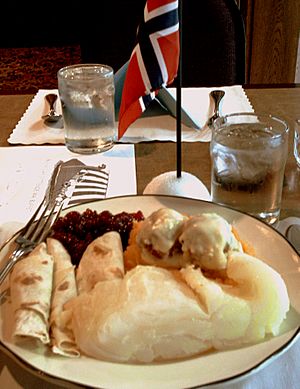
After all the soaking, lutefisk is full of water. It needs to be cooked very carefully so it doesn't fall apart.
- Salting the Fish: Some people sprinkle salt on the fish about 30 minutes before cooking. This helps remove some of the extra water, making the fish firmer. Remember to rinse the salt off before cooking!
Cooking Lutefisk
Lutefisk doesn't need much water to cook. It already has a lot of water from soaking.
- Steaming: You can place the fish in a pan, add a little salt, and cover it tightly. Let it steam cook on very low heat for 20-25 minutes.
- Baking: Another way is to wrap the lutefisk in aluminium foil and bake it in an oven at 225°C (435°F) for 40-50 minutes.
- Boiling: Some people gently boil lutefisk, sometimes wrapped in cheesecloth.
- Microwave: You can even cook lutefisk in a microwave oven. It usually takes about 8-10 minutes for a whole piece of fish.
How Lutefisk is Eaten
Lutefisk is often served with simple side dishes. These usually include boiled potatoes, mashed green peas, melted butter, and small pieces of fried bacon.
- Nordic Traditions: In Norway, Sweden, and Finland, lutefisk is a big part of Christmas meals. It's often served with white sauce. Sometimes, people add allspice or black pepper to the fish, or mustard to the white sauce.
- United States Traditions: In the United States, especially where many people have Scandinavian roots, lutefisk is served with even more side dishes. These can include lefse (a type of flatbread), gravy, mashed rutabaga, syrup, and different kinds of cheese. Sometimes, people even eat it with meatballs, which isn't traditional in Scandinavia.
The taste of well-made lutefisk is quite mild. That's why people often add strong spices like pepper to the white sauce or the fish itself.
Lutefisk Today
More lutefisk is eaten in the United States than in Scandinavia! Many Scandinavian Americans, especially in Lutheran churches and clubs, keep the tradition alive by holding annual lutefisk dinners.
- Lutefisk Capitals: Madison, Minnesota calls itself the "lutefisk capital of the world" because so much lutefisk is eaten there. In Canada, Kingman, Alberta also claims to be a "Lutefisk capital."
- Growing Popularity: In Norway, lutefisk has become more popular as a Christmas meal in recent years. Many restaurants now serve it.
A Fun Lutefisk Story
There's a funny old story about how lutefisk might have been discovered:
A legend says that Viking fishermen used to hang their cod fish on tall wooden racks to dry. One day, some enemy Vikings attacked and burned the fish racks. But then, a big rainstorm came from the North Sea and put out the fire. The fish that was left soaked in a puddle of rainwater and birch ash for months. Later, some hungry Vikings found the fish, prepared it, and had a big feast! This story is a "tall tale", meaning it's a fun, exaggerated story, not necessarily true.
Different Spellings
- Danish: ludfisk or ludefisk
- Norwegian: lutefisk or lutfisk
- Swedish: lutfisk
- Finnish: lipeäkala or livekala
- Sami: lovttaguolli
See also
 In Spanish: Lutefisk para niños
In Spanish: Lutefisk para niños
Images for kids
-
Norwegian Constitution Day dinner in Minnesota, with lutefisk, lefse, and meatballs


